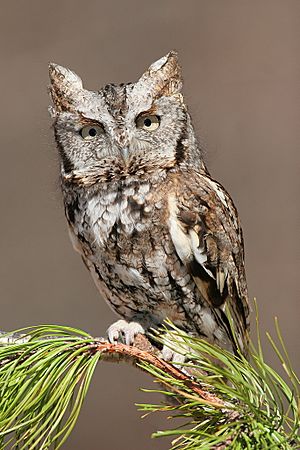True owl facts for kids
Quick facts for kids True owlTemporal range: Early Eocene to present
|
|
|---|---|
 |
|
| Eastern screech owl | |
| Scientific classification |
|
| Kingdom: | Animalia |
| Phylum: | Chordata |
| Class: | Aves |
| Order: | Strigiformes |
| Family: | Strigidae Leach, 1820 |
| Genera | |
|
some 25, see text |
|
| Synonyms | |
|
Striginae sensu Sibley & Ahlquist |
|

True owls, also known as 'Typical owls', belong to the Strigidae family. They are one of two main groups of owls. There are 189 living kinds (species) of true owls, found in 25 different groups (genera). The other owl family is the barn owls. You can find true owls on every continent except Antarctica. These two owl groups have been separate for a very long time.
Contents
What Makes True Owls Special?
True owls come in many different sizes. The smallest is the Elf owl. It weighs much less than the largest owls. The largest true owls are the Eurasian Eagle owl and Blakiston's Fish owl. Most owls look quite similar. They have big heads and short tails. They also have round circles of feathers around their eyes.
Most true owls live in trees. They catch their food while flying. Their wings are large, wide, and rounded. Like other birds of prey, female owls are often bigger than males.
Nighttime Hunters
True owls are nocturnal. This means they are active at night. Because of this, male and female owls look very similar. Their feathers are soft and fluffy at the base. This special feather structure helps them fly silently. This is important for sneaking up on prey.
Amazing Hearing and Sight
Owls have super sensitive hearing. Their ears are not exactly the same on both sides. This asymmetrical ear placement helps them figure out exactly where a sound is coming from. Owls also have very large eyes compared to their body size. These big eyes help them see well in the dark.
Images for kids
-
A tawny owl.
-
The forest owlet, a critically endangered owl.
See also
 In Spanish: Estrígidos para niños
In Spanish: Estrígidos para niños




